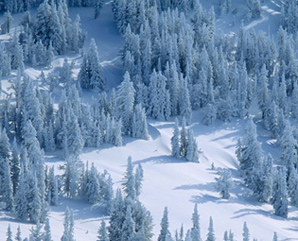
The largest component of the cryosphere is seasonal snow cover. It covers up to 33% (that is one third!) of the Earth’s total land surfaces. About 98% of this can be found in the northern hemisphere. Here, the average snow extent during the winter months ranges from 30 to 40 million km2.
Snow cover has a substantial impact on processes related to the interaction between atmosphere and surface, and understanding snow variables is important for climatology.


According to an IPCC report of 2001, snow cover and ice extent have decreased.
Satellite data seem to show decreases of about 10% in the extent of snow cover since the late 1960s, and ground-based observations seem to show a reduction of about two weeks in the annual duration of lake and river ice cover in the mid- and high latitudes of the Northern Hemisphere, over the 20th century (IPCC).
Almost all climate models
forecast increases in precipitation, though less will fall as snow; but estimates
vary widely and are complicated by many other factors, such as clouds. Combined
changes in temperature and precipitation will produce changes in the pattern
of snow storage and, ultimately, Arctic hydrology. (IPCC)